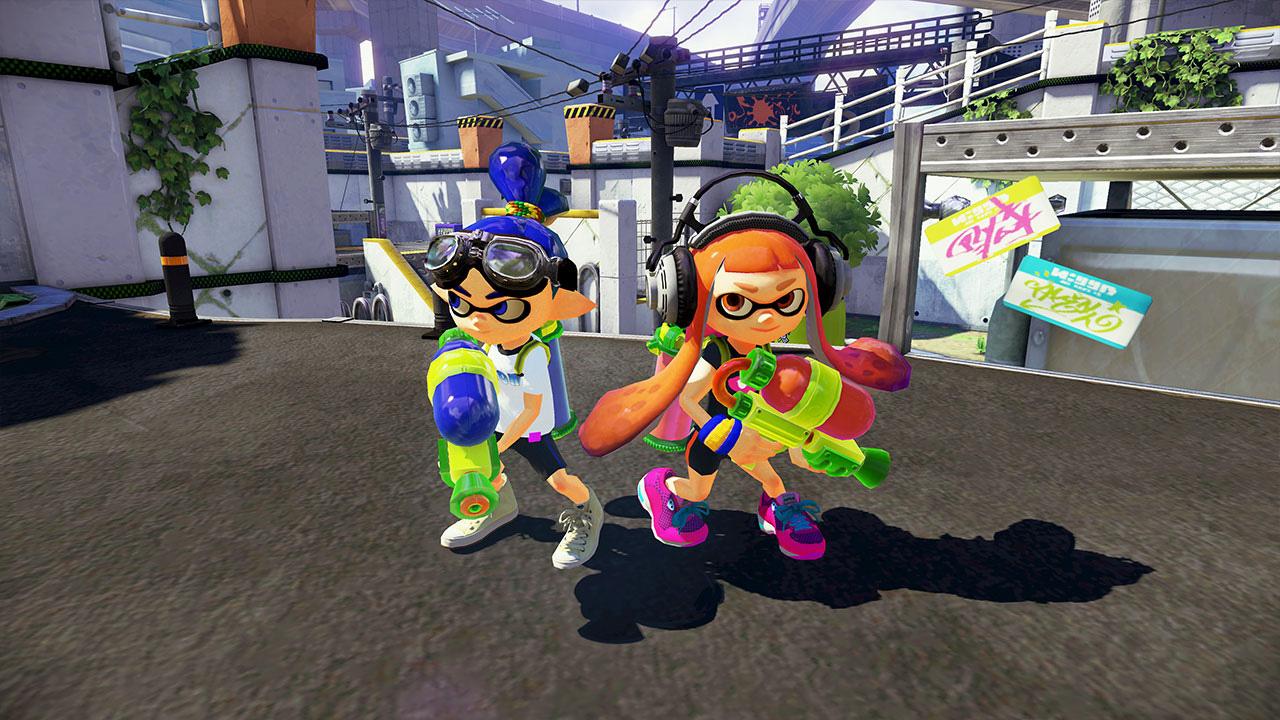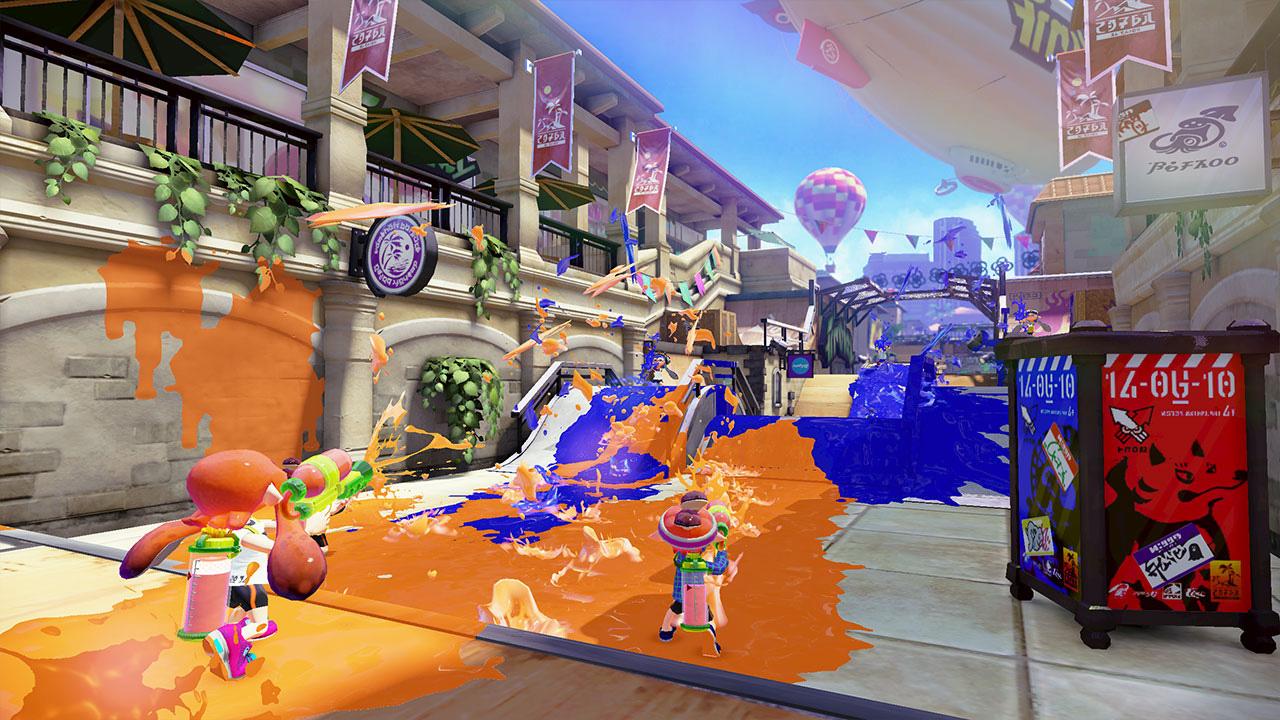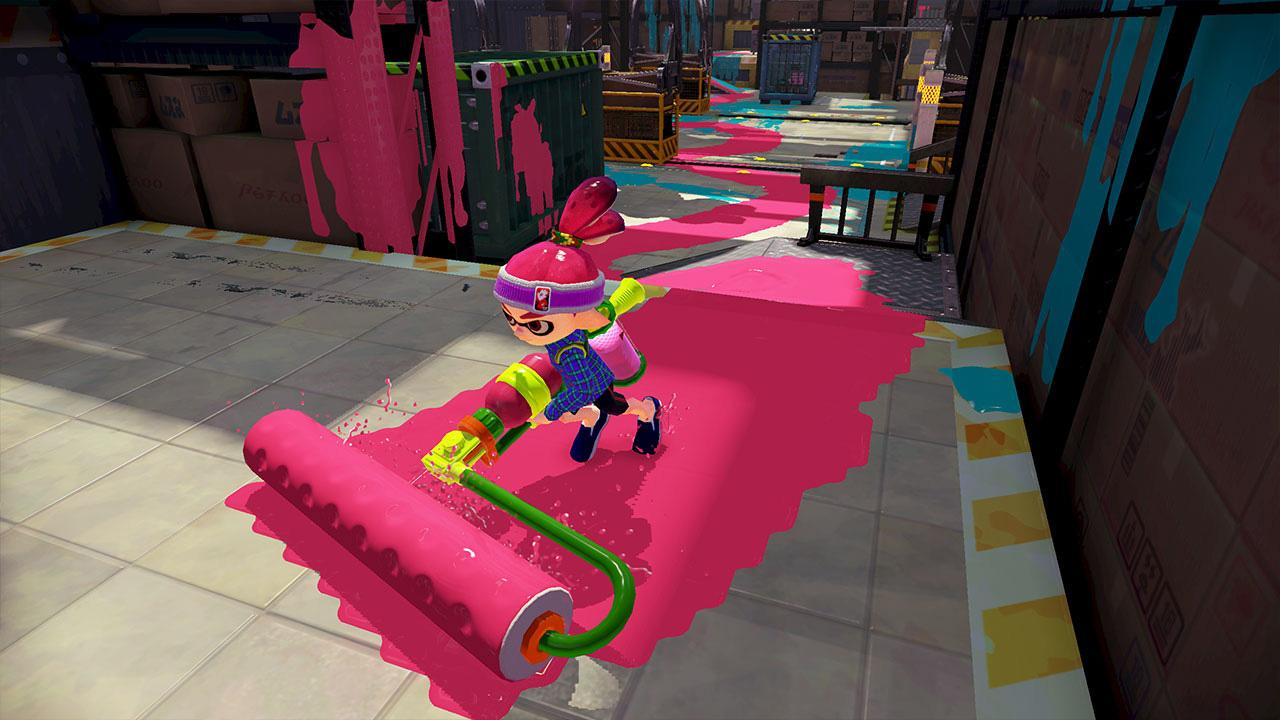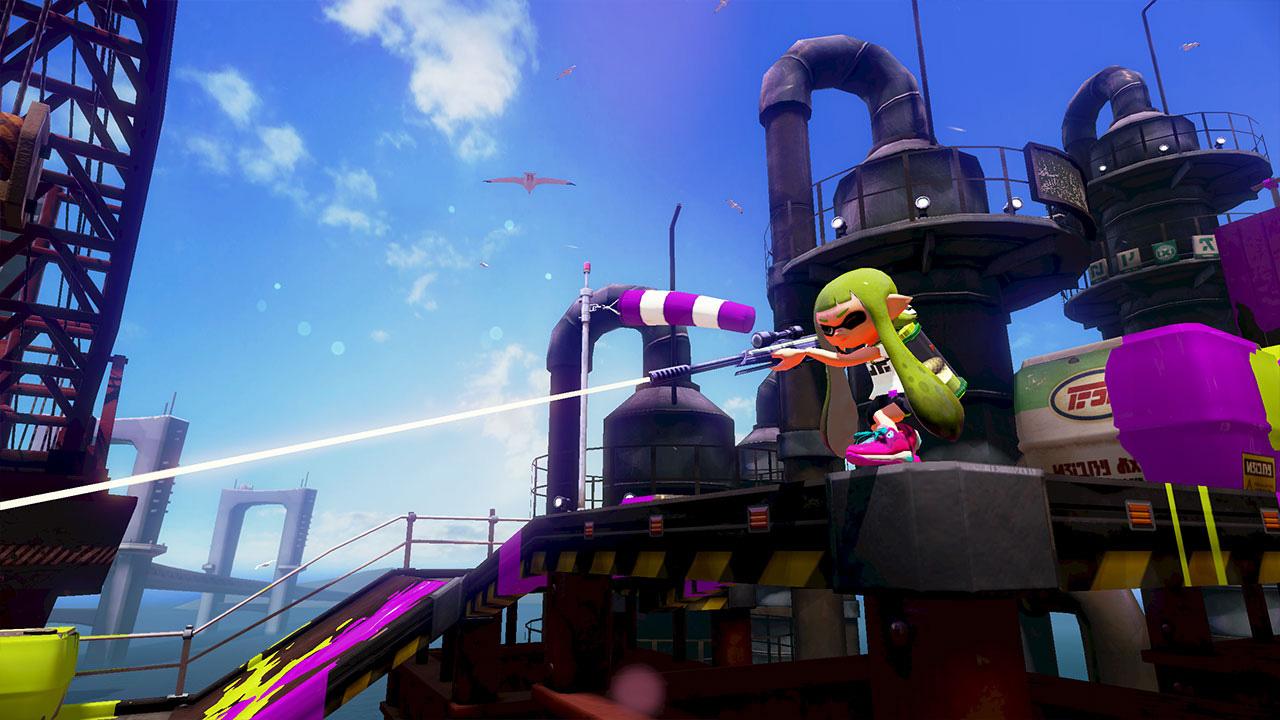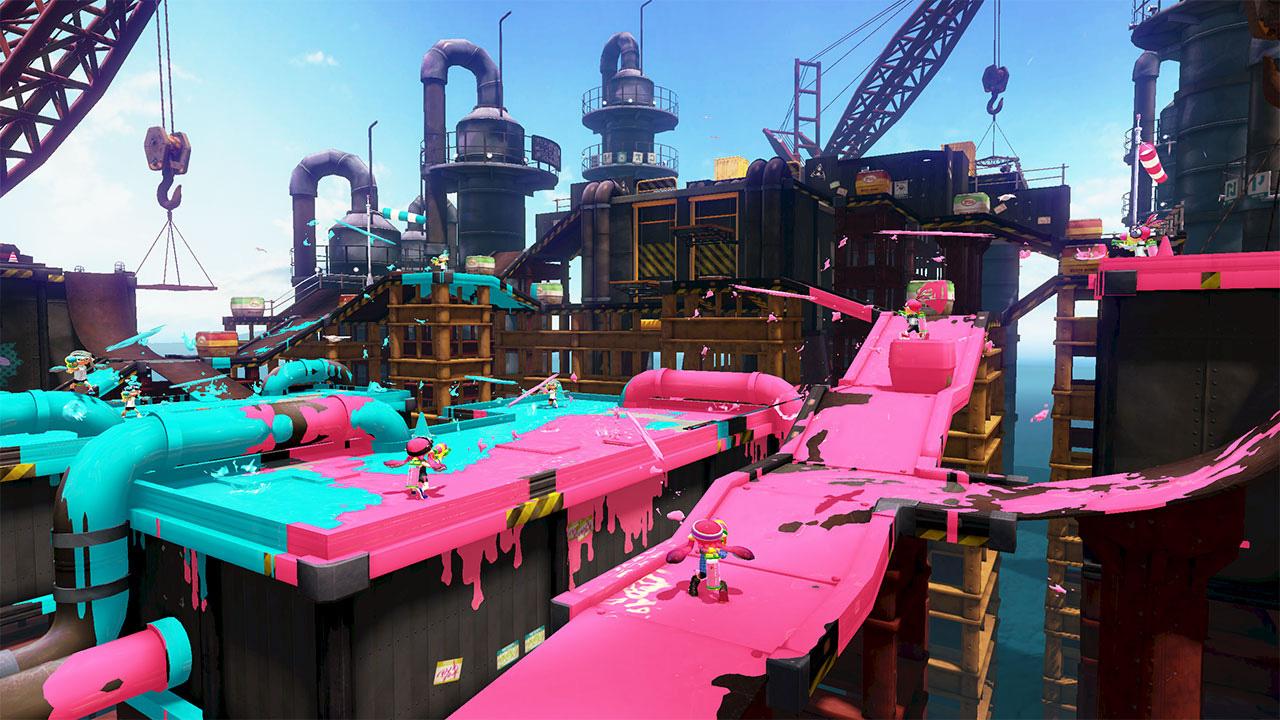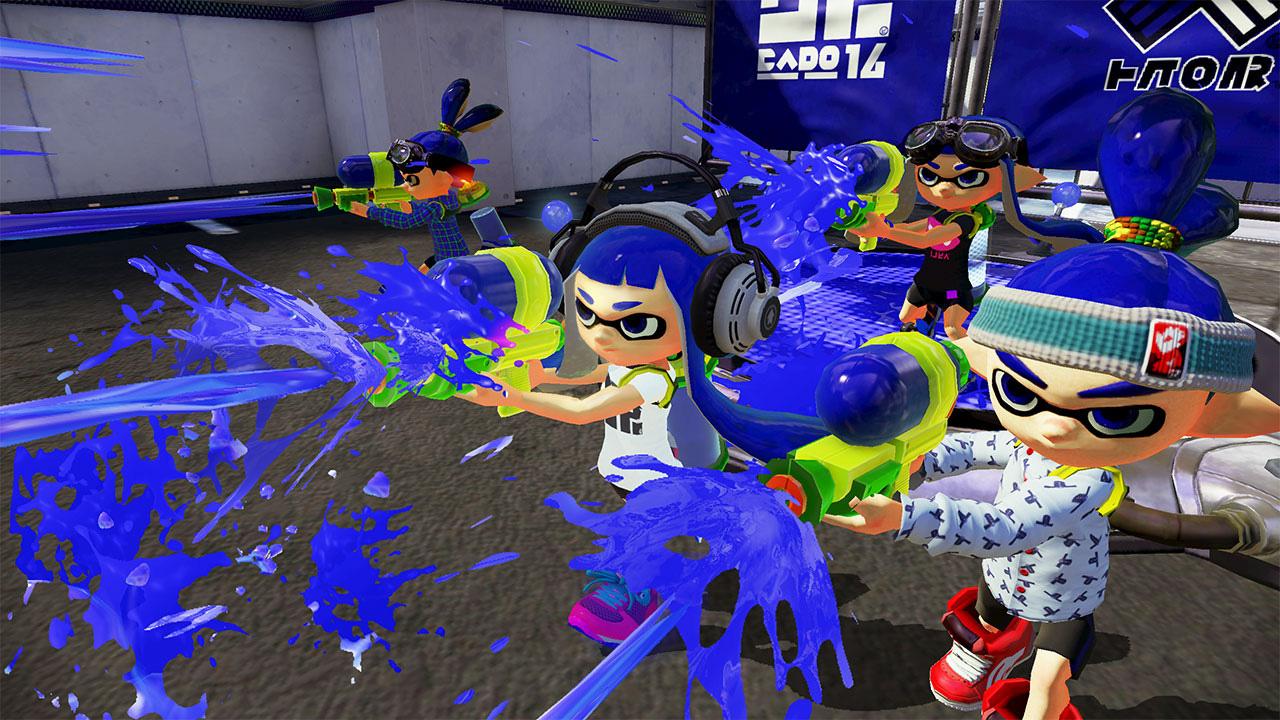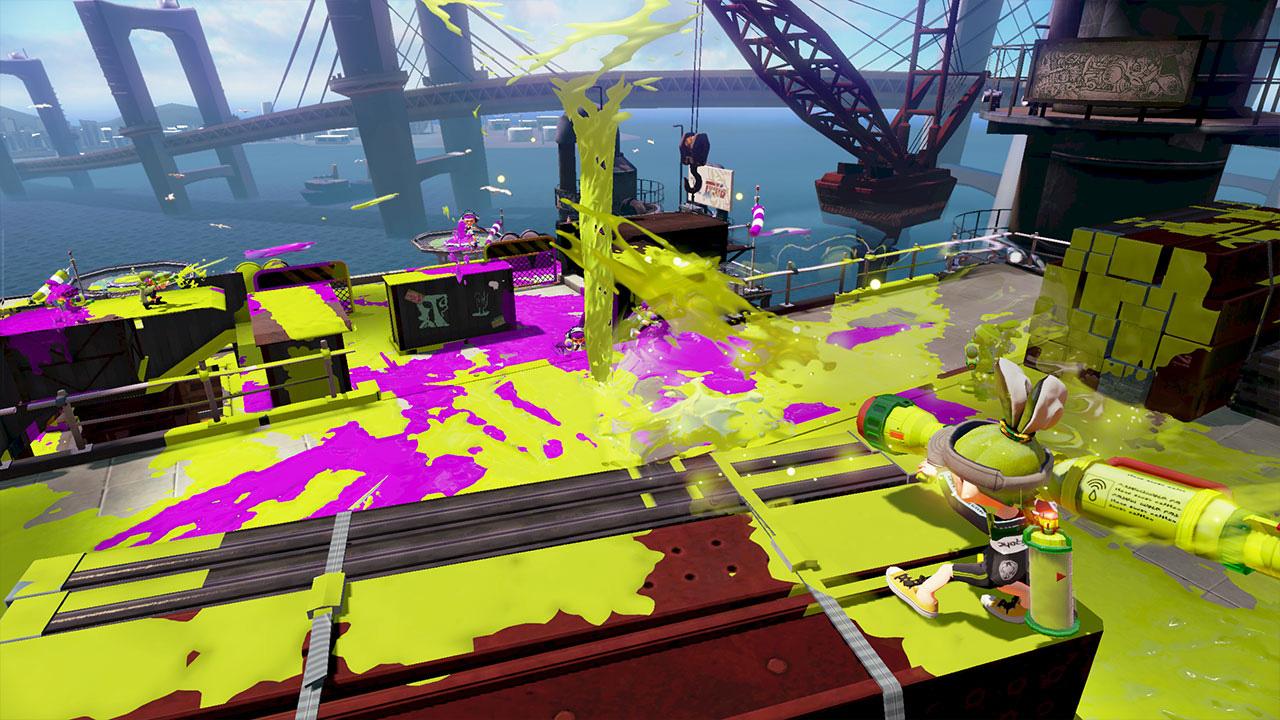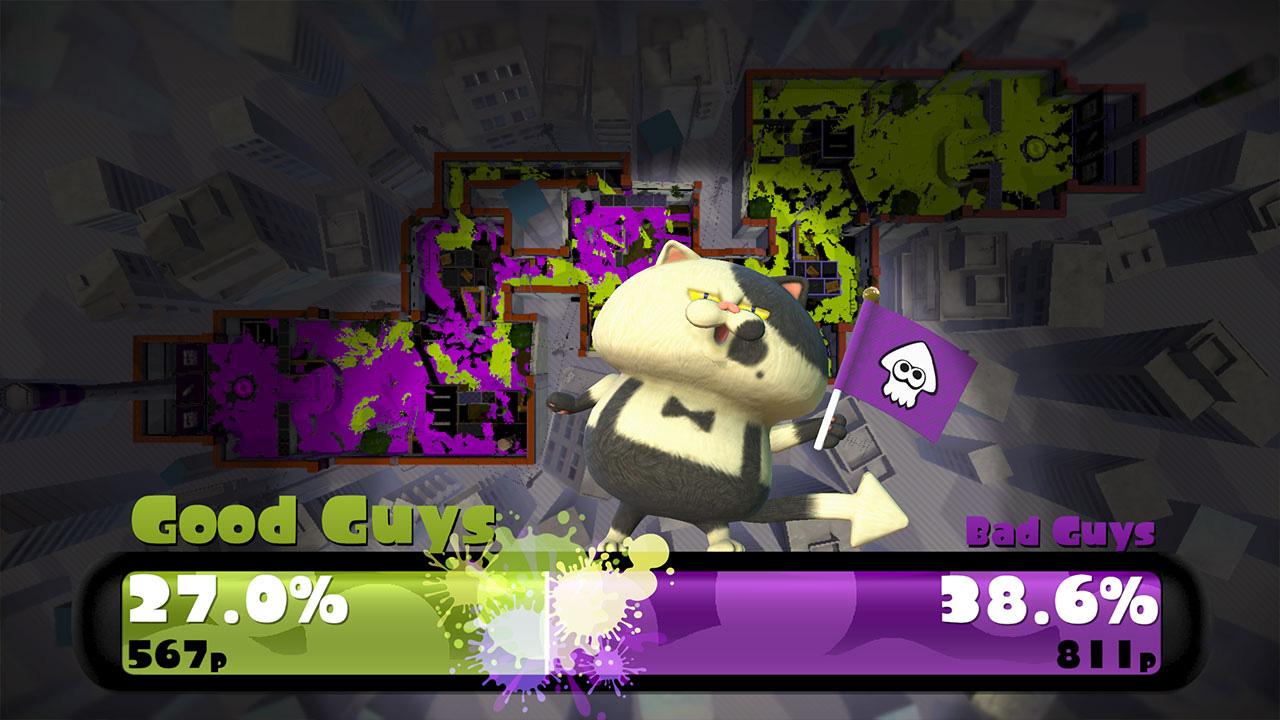When Nintendo revealed Splatoon last year at E3, many fans saw it as an excitingly fresh offering from the venerable company. Developed in-house by a young team, Splatoon is a rare Nintendo game that doesn’t star Super Mario or Pokemon. Instead, it’s filled with a new and bizarre world of ink-shooting squid people.
Splatoon is a third-person shooter with a single-player platforming mode, and both local and online multiplayer. Although a game with guns and shooting definitely falls outside of Nintendo’s traditional wheelhouse, representatives for the company repeatedly told us that it is family-friendly. Instead of focusing on headshots and wounding one another, the real goal is making a mess. We were able to try out all three of Splatoon‘s main gameplay modes, and can confirm that it’s as crazy fun as it looks.
Like Super Smash Bros., Splatoon is immediately accessible, but offers surprising depth. The main conceit is that all of the weapons shoot ink instead of deadly projectiles, which both harms your opponents and splatters your team’s color all over every surface. Players are drastically slowed down in their opponents’ ink. In their own color, however, players are able to freely turn into squids that can swim through the ink at double the speed — even up walls! This also lets their personal ink supply recharge much more quickly. Because you are shooting to harm your opponents and splatter the arena in your team’s ink, the familiar shooting mechanics feel fresh and exciting.
Multiplayer
Online multiplayer is available through a central hub world called Inkopolis Tower. Although it’s possible to play with your friends online, teams are randomized for every match, so you may end up battling your buddies. At any given time, there are two stages to choose from, which rotate every four hours.
Gun-shy players can avoid fighting completely, and instead run around hiding and spreading their team’s color.
Turf War is the standard, team-based multiplayer mode that premiered with the game at E3 last year. Unlike conventional shooters where the kill count is all that matters, in Turf War, the team whose color covers the most surface area when the clock runs out wins the match. Because Splatoon‘s shots do double-duty both attacking and spreading your team’s color, every shot helps your team as long as it spreads more ink, even the ones that miss your opponents. Gun-shy players can avoid fighting completely, and instead run around hiding and spreading their team’s color. There are a surprisingly deep number of strategies teams can experiment with to offensively spread their ink and defend their painted areas.
Ranked matches are also available online, but they’re only available when you reach level 10. At launch, the mode will actually be completely unavailable for everyone until a sufficient number of players worldwide have hit level 10. Once available, ranked matches will have varying rules, like Spat Zone, where teams struggle for control over a particular, small area. New types of gameplay will also cycle in over time, maintaining variety. Nintendo will rank players by their performance using a letter grade, which helps sort them against comparably skilled opponents.
The Battle Dojo mode is pretty fun. It lets you face a friend that’s in the room. It’s different from normal splitscreen multiplayer games because one player uses the Wii U Gamepad and the other a controller with the TV screen. Balloons appear in clusters around the map, and each of you must race around popping them. Each balloon is worth one point, and being taken out by your opponent docks a few from your score. And then, in the final 60 seconds of the match, all points are doubled. This allows for great, last-minute comebacks and keeps both players on their toes until the end. All of the rounds we played swung back and forth dramatically, which is just the kind of excitement you want to keep a game like this interesting — everyone hates a shut-out.
Single player
You can also master your solo skills in Octo Valley, which sprawls beneath Inkopolis. The nasty Octarians (disembodied tentacle creatures right out of Day of the Tentacle) have stolen Inkpolis’ zapfish, and Cap’n Cuttlefish wants you to get them back. (Yes, that’s the story.) Octo Valley is divided into a 20 discrete platforming levels floating in space, and each of them has a zapfish for you to rescue. Nintendo has a well-honed system for designing level progression around the introduction and extrapolation of new mechanics, and those decades of experience are on full display here. Boards feature and recombine gameplay elements with increasing complexity, stretching your skills in new and unexpected directions. These include things like sponges that expand when hit with your ink, but shrink when hit by the enemy’s, or invisible platforms that can only be made apparent by splattering ink on them.
The difficulty progression is smooth, and helps you develop skills that will improve your multiplayer game. There is also no time limit, so you can take on levels at your own pace to make sure you find all of the power eggs, which can be traded for weapon upgrades and sunken scrolls, which reveal the world’s lore. Completing single player missions also unlocks new gear for you to buy in the plaza’s shops.
The single player experience can be extended by using Amiibos. Each of the three Splatoon Amiibos (a boy, a girl, and a squid) unlocks 20 additional challenges, one for each of the Octo Valley boards. The girl Inkling Amiibo tasks you with completing the levels with a charger gun, the boy makes you use a roller, and the squid as either a kraken or with a limited ink supply. Levels that might have been a breeze the first time through with a standard splatter gun suddenly become very tricky, forcing you to rethink your tactics. Completing all of these challenges unlocks special new gear, such as samurai armor.
Arms and armor
The weapons, which look decidedly like Super Soakers, fall into three broad categories. Shooters allow for rapidfire, spraying ink like an assault rifle when you hold the trigger down. Rollers cover the ground more quickly as you run around, doubling as a powerful melee and short range attack weapon when you shake out the ink. Chargers fire at a long range, painting in a straight line after you hold and charge up for a limited time. Variants within the three categories are also available, and mix up the range, spread, and power.
Each weapon also pairs with a particular sub weapons and a special attack. Sub weapons are things like ink grenades, land mines, and turrets. Special attacks are usually a charge up function for your gun, letting you spread more ink on the ground, calling down a huge artillery strike anywhere on the map, or being briefly invincible with a bubble shield. Weapons, subs, and specials are tied together in sets, so you can’t mix and match, unfortunately, but the abilities should be complementary.
The inkling’s stylish gear also does more than just look good — every piece also affects their abilities in some way. Hats, shirts, and shoes can add effects like increased speed, better ink efficiency, or something called “ninja jump.” Every piece starts with a particular ability and a limited number of slots, but these can be upgraded through use over time, allowing players to develop outfits that suit their particular style.
Release date (and upcoming updates)!
In addition to new ranked battle modes, Nintendo promises to regularly update the game with new content and special, community events. Splatfests allow players to select teams for limited times as a sort of metagame, with the best-performing team earning special rewards. It’s similar to the Faction Wars system in Mortal Kombat X, but with teams only lasting for limited times. The first one, coming up this summer, will let players choose whether they represent team Cats or team Dogs.
Nintendo’s decades of gameplay experience are on full display.
A major update in August will flesh out the multiplayer elements with a few new modes. Enhanced matchmaking will let players search for opponents as a fixed team, mastering their skills as a cohesive unit instead of randomizing every match. Custom battles will also allow players to select any arena, instead of the rotating two, with any rule variant and custom teams. The idea seems to be that as that community at large masters the game, Nintendo will gradually roll out more options, rather than throwing everyone into the deep end.

Lastly, fans will be able to get their hands on the game early with the Splatoon Global Testfire. A free demo is available for download now from the Nintendo eStore. Players in any region will be able to get online and try the game out on May 8 from 8 PM to 9 PM PT and May 9 from 4 AM to 5 AM PT and noon to 1 PM PT. Nintendo staffers will be mixed in with the players, distinguished by their white lab coats.
Splatoon arrives exclusively for Wii U on May 28 in Japan and May 29 everywhere else. Pre-ordering will unlock special inkling costumes for your Amiibo fighters in Super Smash Bros.
Editors' Recommendations
- You’ll finally be able to play Half-Life: Alyx on PlayStation VR2 this summer
- 3 new Nintendo Switch games you should try this weekend (May 10-12)
- Nintendo’s next game is all about mastering NES classics
- If you’re looking for a great new Switch game, you’ll dig Pepper Grinder
- Splatoon 3’s Side Order DLC shows that the series can do it all




